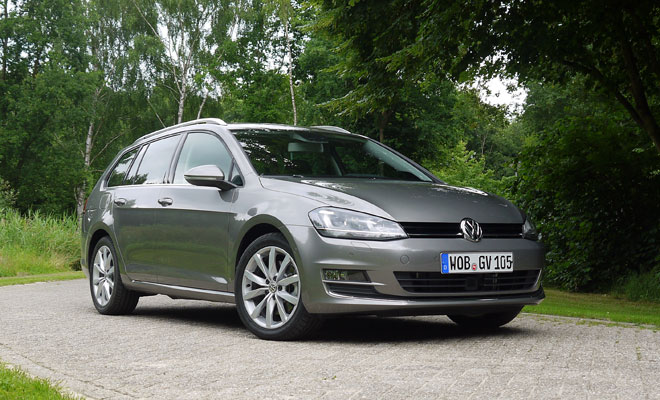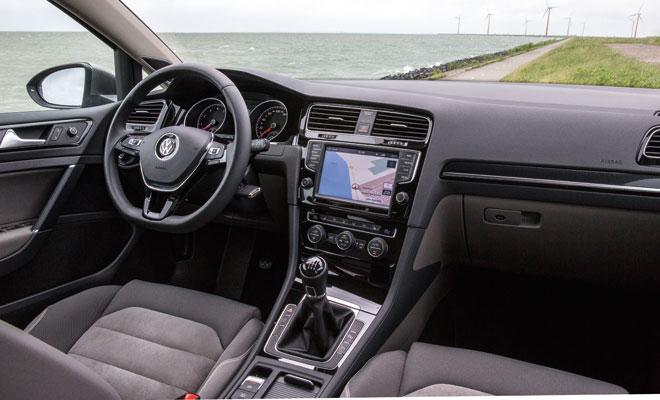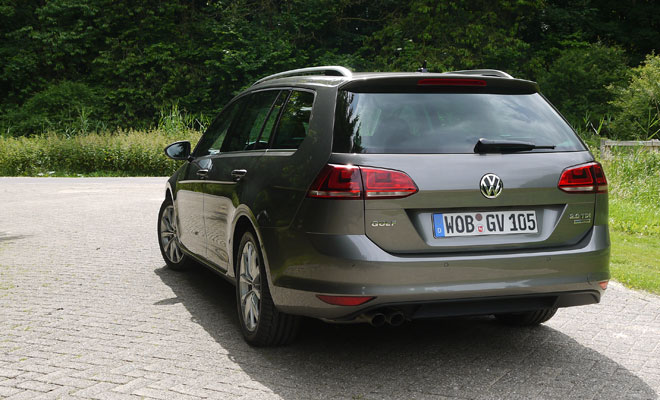by Lem Bingley 
That will be just a 2g/km increase over the miserly BlueMotion Golf hatchback, for a considerable improvement in capability. At 605 litres with the rear seats up, the Estate’s boot is 225 litres larger than the hatchback’s cargo hold, and a fifth bigger than the boot of the outgoing Mk VI Golf Estate.
We must wait for the BlueMotion edition, however, and for now the most economical option is the 1.6 TDI, which scores 102g/km with a manual gearbox or 104g/km with a seven-speed, double-clutch DSG gearbox.

The order books may be open but Golf Estates remain as rare as blue-blooded babies in the UK, hence a jaunt to the Netherlands to test a German-registered, left-hand-drive Golf Estate. My particular example came powered by a 2.0-litre diesel engine, with a six-speed manual box, and in plush GT trim. The car-spotters’ kerbside clue to GT spec lies in the roof rails, which are silvery for the GT and black for the lesser S and SE trim levels.
Engines and trim levels for the Estate are otherwise very similar to the hatchback line-up. S-level trim means 15-inch steel wheels but an otherwise reasonable tally of equipment including Bluetooth, a DAB radio, 5.8-inch touchscreen, air conditioning, an electronic stability system, engine stop-start and regenerative battery charging. SE adds 16-inch alloys, automatic lights and wipers, plus radar-controlled cruise and emergency braking, among other upgrades. And finally GT spec brings 17-inch alloys, pre-installed navigation, parking sensors and Alcantara seats to the party.
Engines range from a 1.2-litre TSI petrol engine producing 85PS to the 2.0-litred TDI producing 150PS. List prices stretch from £17,915 for the manual 1.2 TSI in S trim to £25,855 for the 2.0 TDI GT with a DSG transmission. Model-for-model, the Estate costs £765 more than the corresponding five-door.

The conversion to estate format has been neatly achieved by VW’s designers, who have seamlessly stretched the hatchback’s lines. All of the Estate’s additional foot of length is in the rear overhang, increasing the already laid-back, “cab-rearward” stance of the car.
As with the new seventh-generation hatchback the estate car is longer, wider, lower and lighter than before. Though Golf 7 labels might be a little confusing for the Estate, given that this is only generation five of the longer car. Estates first appeared in 1992, based on the Mk III Golf.
First impressions are of a model that’s simply been heated, stretched, and allowed to set again. There is of course slightly more to the design than that, for example the horizontal crease just below the door handles runs only between the wheels on the hatch, but on the Estate it picks up again behind the rear arches and runs through the rear lamp clusters, connecting with the crease spanning the tailgate.

The tailgate itself is marginally deeper than the hatchback equivalent, necessitating an upward move for the numberplate from bumper to door.
The lines of the Golf have never been rakish – plunging wedge shapes are a little gauche for any brand with premium pretensions – giving the Estate a usefully square rear end with deep side windows. By shifting the Golf’s broad rear pillar back a step, the Estate succeeds in improving over-the-shoulder visibility compared with an ordinary Golf.
The enlarged boot is sensibly cubic, and the rear seats can be released without the need to run around to the side doors. The backs flop forward and lie almost but not quite flat. On some models the front passenger seat can also be folded forwards to carry long and thin things up to about 2.6 metres in length – ideal for a spot of ski jumping, say.

On the move you do feel aware that the car has grown a bit behind you, though the length doesn’t really affect the pace or handling. With the dimensions between engine, wheels and steering wheel entirely unchanged, that’s hardly surprising, while weight has increased by only about 10% overall. I imagine you might notice the difference in handling with a boot full of tumble drier, however.
As with the smaller Golf the rear suspension gets an upgrade for engines delivering power beyond 120PS, designed to keep quicker cars better planted over rough surfaces and in corners. As with the hatchback the difference feels subtle. The torsion-beam setup bolted to the base model cars may be crude in comparison with the pricier option, but it hasn’t exactly been chucked at the car without a care. Either arrangement has been well honed to provide a good compromise between comfort and roadholding, 99% of the time.

Other than the bigger boot, the interior is identical to that found in all new Golfs. The materials are all of good quality and the shapes sober, while small details suggest that designers have often beaten accountants in the decision making. Shut off an air-vent, for example, and the control glides through its orbit as if buttered, before closing with an audible click. There are no Rubik-cube sensations of crummy plastic-on-plastic here.
That said, the design of the dashboard is probably a little too cautious for my taste. A touchscreen is welcome to hoover up the clutter of minor buttons, but I’m not sure it’s in the correct place, dropped down virtually at knee level in the centre console.
All told, though, the Golf Estate provides exactly what it appears to provide – a Golf, stretched out a little longer at the back. It shares all of the strengths and weaknesses of the car on which it’s based. For some, it will be far too boring and predictable, for others, the height of restrained good taste.


VW Golf Estate
Rating: stars
Good: refined, comfortable, capacious, economical
Bad: the BlueMotion Estate is still months away
Price: from £17,915
At the tail end of 2013, Volkswagen will launch a BlueMotion edition of its new Golf Estate. It will mark the first time the full fuel-saving, blue-label treatment has been given to the load-lugging Golf, and the result will be capacious family car with an amazing 87g/km CO2 score. Rating: stars
Good: refined, comfortable, capacious, economical
Bad: the BlueMotion Estate is still months away
Price: from £17,915
That will be just a 2g/km increase over the miserly BlueMotion Golf hatchback, for a considerable improvement in capability. At 605 litres with the rear seats up, the Estate’s boot is 225 litres larger than the hatchback’s cargo hold, and a fifth bigger than the boot of the outgoing Mk VI Golf Estate.
We must wait for the BlueMotion edition, however, and for now the most economical option is the 1.6 TDI, which scores 102g/km with a manual gearbox or 104g/km with a seven-speed, double-clutch DSG gearbox.

The order books may be open but Golf Estates remain as rare as blue-blooded babies in the UK, hence a jaunt to the Netherlands to test a German-registered, left-hand-drive Golf Estate. My particular example came powered by a 2.0-litre diesel engine, with a six-speed manual box, and in plush GT trim. The car-spotters’ kerbside clue to GT spec lies in the roof rails, which are silvery for the GT and black for the lesser S and SE trim levels.
Engines and trim levels for the Estate are otherwise very similar to the hatchback line-up. S-level trim means 15-inch steel wheels but an otherwise reasonable tally of equipment including Bluetooth, a DAB radio, 5.8-inch touchscreen, air conditioning, an electronic stability system, engine stop-start and regenerative battery charging. SE adds 16-inch alloys, automatic lights and wipers, plus radar-controlled cruise and emergency braking, among other upgrades. And finally GT spec brings 17-inch alloys, pre-installed navigation, parking sensors and Alcantara seats to the party.
Engines range from a 1.2-litre TSI petrol engine producing 85PS to the 2.0-litred TDI producing 150PS. List prices stretch from £17,915 for the manual 1.2 TSI in S trim to £25,855 for the 2.0 TDI GT with a DSG transmission. Model-for-model, the Estate costs £765 more than the corresponding five-door.

The conversion to estate format has been neatly achieved by VW’s designers, who have seamlessly stretched the hatchback’s lines. All of the Estate’s additional foot of length is in the rear overhang, increasing the already laid-back, “cab-rearward” stance of the car.
As with the new seventh-generation hatchback the estate car is longer, wider, lower and lighter than before. Though Golf 7 labels might be a little confusing for the Estate, given that this is only generation five of the longer car. Estates first appeared in 1992, based on the Mk III Golf.
First impressions are of a model that’s simply been heated, stretched, and allowed to set again. There is of course slightly more to the design than that, for example the horizontal crease just below the door handles runs only between the wheels on the hatch, but on the Estate it picks up again behind the rear arches and runs through the rear lamp clusters, connecting with the crease spanning the tailgate.

The tailgate itself is marginally deeper than the hatchback equivalent, necessitating an upward move for the numberplate from bumper to door.
The lines of the Golf have never been rakish – plunging wedge shapes are a little gauche for any brand with premium pretensions – giving the Estate a usefully square rear end with deep side windows. By shifting the Golf’s broad rear pillar back a step, the Estate succeeds in improving over-the-shoulder visibility compared with an ordinary Golf.
The enlarged boot is sensibly cubic, and the rear seats can be released without the need to run around to the side doors. The backs flop forward and lie almost but not quite flat. On some models the front passenger seat can also be folded forwards to carry long and thin things up to about 2.6 metres in length – ideal for a spot of ski jumping, say.

On the move you do feel aware that the car has grown a bit behind you, though the length doesn’t really affect the pace or handling. With the dimensions between engine, wheels and steering wheel entirely unchanged, that’s hardly surprising, while weight has increased by only about 10% overall. I imagine you might notice the difference in handling with a boot full of tumble drier, however.
As with the smaller Golf the rear suspension gets an upgrade for engines delivering power beyond 120PS, designed to keep quicker cars better planted over rough surfaces and in corners. As with the hatchback the difference feels subtle. The torsion-beam setup bolted to the base model cars may be crude in comparison with the pricier option, but it hasn’t exactly been chucked at the car without a care. Either arrangement has been well honed to provide a good compromise between comfort and roadholding, 99% of the time.

Other than the bigger boot, the interior is identical to that found in all new Golfs. The materials are all of good quality and the shapes sober, while small details suggest that designers have often beaten accountants in the decision making. Shut off an air-vent, for example, and the control glides through its orbit as if buttered, before closing with an audible click. There are no Rubik-cube sensations of crummy plastic-on-plastic here.
That said, the design of the dashboard is probably a little too cautious for my taste. A touchscreen is welcome to hoover up the clutter of minor buttons, but I’m not sure it’s in the correct place, dropped down virtually at knee level in the centre console.
All told, though, the Golf Estate provides exactly what it appears to provide – a Golf, stretched out a little longer at the back. It shares all of the strengths and weaknesses of the car on which it’s based. For some, it will be far too boring and predictable, for others, the height of restrained good taste.




